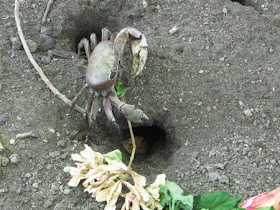Circling Bora Bora, the most scenic of the Society Islands in French Polynesia, on a speedboat gave us a good
overview of the volcanic landscape. And after checking out the lagoon’s
beautiful coral and fish through our snorkels, we decided to explore this
tropical island by land—on a covered open air truck.
 |
| Looking out at the lagoon of Bora Bora |
Starting from Vaitape, the most populous town on the
island (the population of Bora Bora is only about 8,000 people), we headed through
the district of Fa’anui, stopping at the church there for pictures. We stopped again at Fa’anui Bay, a great spot
for photos of the two prominent mountains--Otemanu and Pahia. The truck
continued on to the ancient ceremonial site of Fa’anui Marae, designated by an
ancient carved boulder—and then on to see bunkers constructed by American GIs
during World War II.
 |
| Creating beautiful pareos with intricate designs |
 |
| Refreshing island fruits |
Many of the pareos have the name of the island, Bora
Bora spelled out. This is achieved by placing stencils on the fabric and
allowing the sun to bleach out the words or to create new designs. The lightweight fabric is a local wardrobe mainstay
because it can be twisted and crossed hundreds of ways into many garments. Our
guide demonstrated how to make a skirt, dress, or jacket—worn by men as well as
women. Then we sampled local fruits such as breadfruit, banana, coconut, grapefruit,
and passion fruit, and I purchased a hand-painted pareo--wearable art--to take home.
 |
| Crabs scamper to retrieve flowers that are dragged into their holes |
Flowers, mostly hibiscus, hung by each seat of
the truck. Nice touch, I thought, not knowing that there was a purpose beyond decoration.
At a sandy area, dozens of holes—homes for sand crabs—made walking around tricky. Told to throw the flowers on the
ground, we did and watched in amazement as the voracious critters scurried out
of their holes, grabbed the flowers (which were much bigger than they were),
and dragged these prizes back into their holes.
 |
| Bora Bora has beautiful white sand beaches. |
 |
| Sandy floor at Bloody Mary's restaurant and bar |
Photos by Larry and Beverly Burmeier
No comments:
Post a Comment